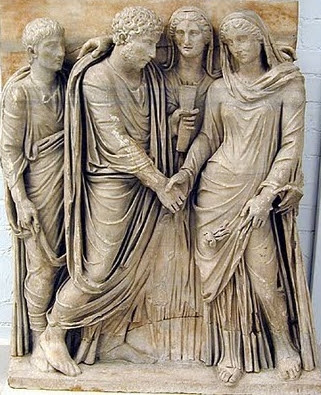
The following genetic analysis shows the origins of the indo-European patriarchal pastoral culture called Kurgan (from the tumuli used to bury the dead). This is very intriguing since the birthplace of Arian civilization is halfway between Europe and the Indus Valley. This culture, also mentioned by Archaeologist M. Ginbutas in his book on the disappearance of matriarchy in ancient Europe (attributed to the Kurgan invasion), was deeply rooted in the North of India, passing through Iran to all Europe, Italy and Greece included. Indeed, all European languages are of Indo-European matrix as Sanskrit.
Whether these Kurgan or Jamna were initiators of warlike pastoral civilization would have no doubt ... A curiosity in the North of India still exists a sacred river called Jamna ... Jamna's culture (about 3500-2500 BC) according to the researchers was a nomadic culture, originated between Caspio and Ponto, characterized by inmates in the famous kurgan (tumuli).
Jamna's culture developed in the late Neolithic Age, was a nomadic culture of the steppes, between Caspian and Ponto, characterized by inmates in the famous Kurgan. It is identified as the ancestral nucleus of Proto-Indo-European language formation spoken by native Indo-Europeans, Aryans or Aries, coming from the Caucasus region, probably between the end of the Neolithic and the beginning of the Copper Age.
Paolo D'Arpini

Genetic traces of Aryan culture
- Also known as the Yamnaya Culture, Pit Grave Culture or Ochre Grave Culture.
- Generally considered by linguists as the homeland of the Proto-Indo-European language.
- Probably originated between the Lower Don, the Lower Volga and North Caucasus during the Chalcolithic, around what became the Novotitorovka culture (3300-2700 BCE) within the Yamna culture.
- Highly mobile steppe culture of pastoral nomads relying heavily on cattle (dairy farming). Sheep were also kept for their wool. Hunting, fishing and sporadic agriculture was practiced near rivers.
- First culture (along with Maykop) to make regular use of ox-drawn wheeled carts. Metal artefacts (tools, axes, tanged daggers) were mostly made of copper, with some arsenical bronze. Domesticated horses used as pack animal and ridden to manage cattle herds.
- Coarse, flat-bottomed, egg-shaped pottery decorated with comb stamps and cord impressions.
- The dead were inhumed in pit graves inside kurgans (burial mounds). Bodies were placed in a supine position with bent knees and covered in ochre. Wagons/carts and sacrificed animals (cattle, horse, sheep) were present in graves, a trait typical of later Indo-European cultures.
DNA Samples
The following mtDNA samples were tested by Wilde et al. (2014). Deep subclades were not reported in the paper and were determined by Maciamo based on the raw data.
Samples from the Volga region
- KAL : Kalinovka I, Samara Oblast (Middle Volga), Russia
- NIK : Nikolaevka III, Samara Oblast (Middle Volga), Russia
- POD : Podlesnyj, Samara Oblast (Middle Volga), Russia
Samples from the Don and Kuban regions
- OLE : Olennii, Krasnodar Krai (Sea of Azov), Russia
- PEJ : Peschanyi, Rostov Oblast, Russia
Samples from central and eastern Ukraine
- PES : Pestchanka II, central eastern Ukraine
- SUG : Kirovograd Sugokleya, central Ukraine
- VIN : Vinogradnoe, southern central Ukraine
Samples from western Ukraine & Moldova
- MAJ : Mayaki, southwest Ukraine
- TET : Tetcani, northern Moldova
Samples from Bulgaria
- OVI : Ovchartsi, south-east Bulgaria
- POP : Popovo, south-east Bulgaria
- RIL : Riltsi, north-east Bulgaria
………….
Testo italiano
Dall'analisi genetica soprastante si evince l’origine della cultura pastorale patriarcale indo-europea denominata Kurgan (dai tumuli usati per seppellire i morti). La cosa è molto intrigante poiché il luogo di nascita delle civiltà ariana si pone a metà strada fra l’Europa e la Valle dell’Indo. Questa cultura, di cui parlò anche l’archeloga M. Ginbutas nel suo libro sulla scomparsa del matriarcato nell’Europa antica (attribuita all’invasione Kurgan), si è ben radicata nel Nord dell’India, passando per l’Iran sino a tutta l’Europa, Italia e Grecia comprese. Infatti tutte le lingue europee sono di matrice indo-europea come il sanscrito.
Che questi Kurgan o Jamna fossero stati gli iniziatori della civiltà pastorale guerriera non sussisterebbero dubbi… Una curiosità nel nord dell’India tuttora esiste un fiume sacro chiamato Jamna… La cultura di Jamna (circa 3500-2500 avanti Cristo) secondo i ricercatori fu una cultura nomadica, sorta tra Caspio e Ponto, caratterizzata dalle inumazioni nei famosi kurgan (tumuli).
La cultura di Jamna si sviluppò nella tarda Età neolitica, fu una cultura nomadica delle steppe, tra Caspio e Ponto, caratterizzata dalle inumazioni nei famosi kurgan (tumuli). Viene identificata come nucleo ancestrale di formazione delle lingue proto-indoeuropee parlate dagli Indoeuropei originari, gli Ariani o Ari, provenienti dall’area del Caucaso, probabilmente tra la fine del neolitico e l’inizio dell’Età del Rame.
Paolo D’Arpini

Articolo collegato: http://


Nessun commento:
Posta un commento
Nota. Solo i membri di questo blog possono postare un commento.